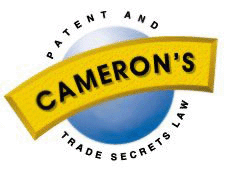
Beecham Canada Ltd. v.
Procter & Gamble Co.
citation(s): (1982) 61 C.P.R. (2d) 1 (F.C.A. per Urie J.A.)
 |
Beecham Canada Ltd. v.
|
copyright 1997 Donald M. Cameron, Aird & Berlis
At p.11
"Counsel for the respondent argued that even if the appellants' substrate is not a web, strictly construed, there has been infringement by the taking of the substance of the invention. As earlier stated, the invention is the discovery that fabrics could be conditioned in a domestic dryer by commingling damp fabrics with a flexible substrate carrying a transferable conditioning agent. The question thus is, does Cling Free embody the substance of the respondents invention? As a first observation in answering that question I do not think that the nature of the substrate is part of the invention claimed. All that is required is a "suitable" substrate. If that is so then the question must be answered in the affirmative limiting that answer solely to the question put without reference to the defences raised. The substrate quite apparently not being part of the invention it becomes one of the minor variants to which Lord Diplock referred in the Catnic case, supra, "which could have no material effect on the way the invention worked"(emphasis added). The fact that the Cling Free substrate may not be a web can have no bearing on the question of infringement in this case."
At p.19-21
"Counsel submitted that if the claims extend to include a substrate which is not coated with a conditioning agent (i.e. only impregnated therewith) there cannot be infringement because they are invalid on the ground that they are not supported by the disclosure in the patent and are broader than the disclosure. The basis upon which this argument is advanced is what counsel referred to as the cardinal principle of patent law, namely, that an inventor may not validly claim what he has not described. If he does so, the claims not supported by the disclosure are invalid."
... Having so found and the claims similarly having no such limitations, I agree with the finding that they are not broader than the disclosure and, thus, cannot be said to be invalid. This attack on the judgment under appeal therefore fails."
At p.24
"I turn now to the appeal from that part of the judgment relating to the defences of invalidity. It is common ground that by reason of the presumption of validity of a patent provided by s. 47 of the Patent Act, the onus falls upon the appellants to prove its allegations of invalidity."
At p.27
“The question to be answered is whether at the date of invention...an unimaginative skilled technician, in light of his general knowledge and the literature and information on the subject available to him on that date, would have been led directly and without difficulty to [the] invention."
"The question to be answered is whether at the date of invention (August-September, 1964) an unimaginative skilled technician, in light of his general knowledge and the literature and information on the subject available to him on that date, would have been led directly and without difficulty to Gaiser's invention. As the learned trial Judge observed even if he had accepted the evidence of the 19 witnesses, what they did (i.e., their activities in this area), did not form part of the knowledge of the competent addressee of the Gaiser patent."
Return to:
Cameron's IT Law: Home Page; Index
Cameron's Canadian Patent & Trade Secrets Law: Home Page; Index